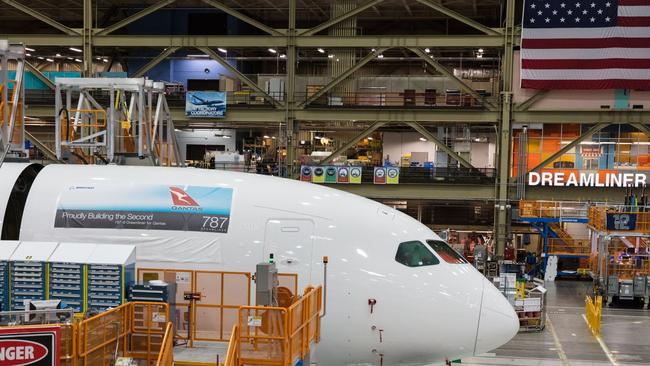Boeing’s Dreamliner set to stretch Qantas’s wings on new routes
Eight Boeing 787 Dreamliners will open new routes for Qantas when the fuel-efficient planes are delivered next year.

When Qantas boss Alan Joyce reveals this week whether he has chosen “quokka”, “boomerang” or another Australian icon as the name for the Dreamliner fleet, he will answer one question around the plans for the carrier’s first new fleet type since 2008. But other questions will remain unanswered.
This week, the Irish-born Joyce will take delivery of the Boeing 787 from the US aerospace giant Boeing’s cavernous facility at Everett in Washington state.
The Dreamliner — which will eventually replace Qantas’s older “queen of the skies” Boeing 747-400s, and is the first new type since Qantas took delivery of the a380 superjumbo in 2008 — will initially be used to fly Melbourne to Los Angeles, then also the non-stop Perth-London route.
Of eight Dreamliners that Qantas has committed to take delivery of, four will be based in Brisbane, but there are questions about where most of the second tranche will fly to. Also unknown is what decisions will be made on the 45 further options and purchase rights on the Dreamliner that span to the mid-2020s.
Speaking from Everett, Mr Joyce said that as well as possibly opening up pairs such as Perth to Paris or Brisbane to Chicago, the new aircraft would be able to open other routes. It was also flagged that the aircraft would fly from Brisbane to Los Angeles then onward to New York, with the 787 replacing the Brisbane to LA route that is now flown on the 747.
“The next four, we haven’t fully announced where we’re going to use them,” Mr Joyce said.
Out of Brisbane, “we want to fly somewhere new in the States”.
“That will either be Seattle, it could be here … it could be Chicago, it could be Dallas. We are waiting until we get closer to when those aircraft arrive to make the announcement so you will see a new route into the US from Brisbane.”
Qantas International chief executive Gareth Evans said: “Because of the size, these aircraft are also going to be great for our Asian network as well.” With 236 seats, there was a great opportunity “to use these wonderfully flexible and efficient aircraft right around our network”. Mr Evans said the airline’s partnership with Emirates remained important but the 787 “certainly gives Qantas the capability to start to grow into parts of the world that we’ve been unable to economically and profitably serve with the technology that has gone to date”.
Mr Joyce said the eight 787s, which Qantas committed to take in 2015, were “a minimum”.
“Eventually we will be ordering more of the 787s because we think it’s a great aircraft,” he said. “It’s just the pace and what time we do that.”
He said “into next year we have to start making calls about what we do” in relation to the 45 further options. “And what we want to do, which I think is fair, is to demonstrate to the market, to demonstrate to our shareholders, that these 787s are making an economic difference to our profitability and we can make good money out of them operating these routes. So, before we order any more, I think it’s imperative upon us to demonstrate that return.”
The fuel savings and appeal to flyers are big selling points.
“I think its trip economics, its bottom line, is going to be fantastic,” said Emirates president Tim Clark. “I’m sure Alan and his planner know exactly (what they will be able to do with the plane).”
Sir Tim said the non-stop Perth-to-London route that starts in March next year “will be a real litmus test to see how that works with the cabin size in economy”.
“But given the strength of that particular market, I’m sure he will fill the airplanes all the time,” Sir Tim said.
The 787 has saved 18 billion pounds of fuel since it started flying, according to a media presentation at Everett by Jim Freitas, Boeing’s commercial planes managing director of product marketing and analysis. He pointed to features such as the longer wingspan and composite materials resulting in lower fuel use.
Aviation analyst Neil Hansford, chairman of Strategic Aviation Solutions, said that having an aircraft like the Dreamliner would be particularly important “if the worm turned”.
“The ability to go direct and to go to smaller destinations will be really significant,” he added, noting that low-cost subsidiary Jetstar had already “gone through all the pain of the introduction” as it already had Dreamliners.
Mr Hansford said it was a shame Qantas had cancelled and deferred some orders in 2009, which it did amid turbulent times for airlines worldwide. Earlier this year, Qantas brought forward the delivery, so all eight Dreamliners will take wing by the end of 2018, instead of mid-2019.
Ian Douglas, a senior lecturer with the school of aviation at the University of NSW, said the fact the aircraft could bypass hubs was significant. “This finally gives Qantas the opportunity to say we will control our own market,” Dr Douglas said.
Annabel Hepworth travelled to Seattle as a guest of Qantas and Boeing.



To join the conversation, please log in. Don't have an account? Register
Join the conversation, you are commenting as Logout